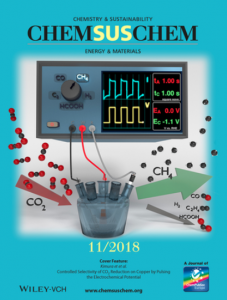Kevin’s recent paper on electrochemical CO2 reduction showed that pulsing the applied potential provides a rich parameter space of previously under appreciated ‘knobs’ to tailor the selectivity of reduced products. More information can be found in the Full Paper by Kimura et al. (https://onlinelibrary.wiley.com/doi/abs/10.1002/cssc.201801130).

Electrochemical CO2 reduction reaction (CO2RR) has garnered strong interest as a promising pathway to convert CO2 emissions into higher value chemicals including fuels and hydrocarbon feedstocks. In particular, copper has been shown to produce a range of useful hydrocarbons at room temperature, which could be powered renewably. The main challenges involved with CO2RR is the low selectivity to one product, competition with the hydrogen evolution reaction (HER) and the overall high overpotentials required. Applying the electrochemical potential in a time-programmed pulse (instead of a constant potential) has interesting implications on both fundamental and applied aspects of CO2RR. From a fundamental perspective, the timing of the square wave pulsed potential provides insights into the coupled dynamics of mass transport and surface reactions. From an applied perspective, pulsed potentials significantly mitigate electrode fouling in electrolytic cells. Intrigued by the prospects of pulsed potentials applied to CO2RR we sought out to understand the underlying mechanism responsible for pulse dependent product selectivity.
We found that the application of a pulsed potential allows us to substantially suppress the HER while shifting selectivity to CH4 and CO. We attribute the improved CO2RR selectivity to a re-arrangement of surface hydrogen coverage during the pulsing. We also establish that the size and geometry of the electrode matters; when using a small copper electrode, HER was suppressed to less than 5% and methane or CO could be selectivity produced even at fairly low potentials. To decouple the interplay of surface reactions and mass transport to and from the electrode we performed rotating disk electrode experiments and compared the results to an analytical model.
On a fundamental level, our findings provide new insights into the timescales of competing pathways in CO2RR. From an applied perspective, our results present an opportunity for the product selectivity to be tuned by adjusting the temporal profile of the electrochemical potential. We anticipate our findings may help others to further understand the CO2RR pathways and improve performance for other electrocatalysts.

